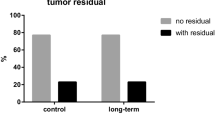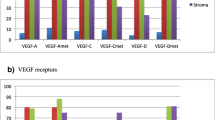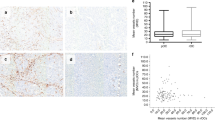Abstract
Angiogenic factors play a role in tumor growth and spread. The object of this study was to analyze the correlation between mRNA expression of angiogenesis-related genes and disease outcome in advanced-stage ovarian carcinomas. Sections from 66 primary ovarian carcinomas and metastatic lesions from 41 patients diagnosed with advanced stage ovarian carcinoma (FIGO stages III-IV) were evaluated for expression of basic fibroblast factor (bFGF), interleukin-8 (IL-8), and vascular endothelial growth factor (VEGF) using mRNA In Situ Hybridization (ISH). Patients were divided in two groups based on disease outcome. Long-term survivors (17 patients) and short-term survivors (24 patients) were defined using a double cut-off of 36 months for disease-free survival (DFS) and 60 months for overall survival (OS). Mean follow-up period was 70 months. The mean values for DFS and OS were 116 and 133 months for long-term survivors, as compared to 3 and 21 months for short-term survivors, respectively. Expression of bFGF mRNA, most often intense, was detected in tumor and stromal cells in the majority of cases. Weak expression of IL-8 mRNA was detected in both cell compartments, while VEGF mRNA expression was limited to few cases. Primary tumors displayed higher bFGF and IL-8 mRNA expression. However, these differences did not reach statistical significance (P>0.05). bFGF, IL-8 and VEGF mRNA expression in both tumor and stromal cells was comparable in tumors of long-term and short-term survivors, and showed no correlation with disease outcome in survival analysis (P>0.05). bFGF is the major angiogenic factor expressed in ovarian carcinoma at the mRNA level. mRNA expression of VEGF, bFGF, and IL-8 does not appear to be a predictor of disease outcome in advanced-stage ovarian carcinoma.
Similar content being viewed by others
References
Folkman J. Tumorangiogenesis. Adv Cancer Res. 1985 43:175-203.
Folkman J. What is the evidence that tumors are angiogenesis dependent? J Natl Cancer Inst 1990; 82: 4–6.
Fidler IJ, Ellis LM. The implications of angiogenesis for the biology and therapy of cancer metastasis. Cell 1994; 79: 185–8.
Folkman J, Klagsbrun M. Angiogenic factors. Science 1987; 235: 442–7.
Tischer E, Mitchell R, Hartman T et al. The human gene for vascular endothelial growth factor. J Biol Chem 1991; 226: 11947–54.
Keck PJ, Hauser SD, Krivi G et al. Vascular permeability factor: an endothelial cell mitogen related to PDGF. Science 1989; 246: 1309–12.
Goldfarb M. The fibroblast growth factor family. Cell Growth Diff 1990; 1: 439–45.
Gospodarowicz D, Neufeld G, Schweigerer L. Molecular and biological characterization of fibroblast growth factor: An angiogenic growth factor which also controls the proliferation and differentiation of mesoderm and neuroectoderm derived cells. Cell Diff 1986; 19:1–17.
Koch AE, Polverini PJ, Kunkel SL et al. Interleukin-8 as a macrophage-derived mediator of angiogenesis. Science 1992; 258: 1798–801.
Parkin DM, Pisani P, Ferlay J. Global cancer statistics. CA Cancer J Clin 1999; 49: 33–64.
Petterson F. International Federation of Gynecology and Obstetrics: Annual report on the results of treatment in gynecological cancer. Stockholm: Panorama Press AB 1995; 83–102, 201-27.
Hazelton D, Nicosia RF, Nicosia SV. Vascular endothelial growth factor levels in ovarian cyst fluid correlate with malignancy. Clin Cancer Res 1999; 5: 823–9.
Chen C-A, Cheng W-F, Lee C-N et al. Serum vascular endothelial growth factor in epithelial ovarian neoplasms: correlation with patient survival. Gynecol Oncol 1999; 74: 235–40.
Tempfer C, Obermair A, Hefler L et al. Vascular endothelial growth factor serum concentrations in ovarian cancer. Obstet Gynecol 1998; 92: 360–3.
Gadducci A, Ferdeghini M, Fanucchi A et al. Serum preoperative vascular endothelial growth factor (VEGF) in epithelial ovarian cancer: relationship with prognostic variables and clinical outcome. Anticancer Res 1999; 19: 1401–6.
Nakanishi Y, Kodama J, Yoshinouchi M et al. The expression of vascular endothelial growth factor and transforming growth factor-β associates with angiogenesis in epithelial ovarian cancer. Int J Gynecol Pathol 1997; 16: 256–62.
Hartenbach EM, Olson TA, Goswitz JJ et al. Vascular endothelial growth factor (VEGF) expression and survival in human epithelial ovarian carcinomas. Cancer Lett 1997; 121: 169–75.
Mattern J, Stammler G, Koomagi R et al. Association of vascular endothelial growth factor expression with tumor cell proliferation in ovarian carcinoma. Anticancer Res 1997; 17: 621–4.
Garzetti GG, Ciavattini A, Lucarini G et al. Vascular endothelial growth factor expression as a prognostic index in serous ovarian cystadenocarcinomas: relationship with MIB1 immunostaining. Gynecol Oncol 1999; 73: 396–401.
Yamamoto S, Konishi I, Mandai M et al. Expression of vascular endothelial growth factor (VEGF) in epithelial ovarian neoplasms: correlation with clinicopathology and patient survival, and analysis of serum VEGF levels. Br J Cancer 1997; 76: 1221–7.
Paley PJ, Staskus KA, Gebhard K et al. Vascular endothelial growth factor expression in early-stage ovarian carcinomas. Cancer 1997; 80: 98–106.
Obermair A, Speiser P, Reisenberger K et al. Influence of intratumoral basic fibroblast growth factor concentrations on survival in ovarian cancer patients. Cancer Lett 1998; 130: 69–76.
Ivarsson K, Runesson E, Sundfeldt K et al. The chemotactic cytokine interleukin-8-a cyst fluid marker for malignant epithelial ovarian cancer? Gynecol Oncol 1998; 71: 420–3.
Davidson B, Goldberg I, Gotlieb WH et al. High levels of MMP-2, MMP-9, MT1-MMP and TIMP-2 mRNA correlate with poor survival in ovarian carcinoma. Clin Exp Metastasis 1999; 17: 799–808.
Davidson B, Reich R, Goldberg I et al. Ets-1 mRNA expression is a novel marker of poor survival in ovarian carcinoma. Clin Cancer Res 2001; 7: 551–7.
Davidson B, Gotlieb WH, Ben-Baruch G et al. E-cadherin complex protein expression and survival in ovarian carcinoma. Gynecol Oncol 2000; 79: 362–71.
Davidson B, Gotlieb WH, Ben-Baruch G et al. Expression of carbohydrate antigens in advanced-stage ovarian carcinomas and their metastases-a clinicopathologic study. Gynecol Oncol 2000; 77: 35–43.
Young RH, Clement PB, Scully RE. Surface epithelial-stromal tumors. In Sternberg SS, Antonioli DA, Carter D, Mills SE, Oberman HA (eds): Diagnostic Surgical Pathology, 3rd edition. Philadelphia: Lippincott Williams &;; Wilkins 1999; 2319–82.
Parks CS, Brigati DJ, Manahan LJ. Automated molecular pathology: one-hour in-situ DNA hybridization. J Histotechnol 1991; 14: 219–29.
Reed JA, Manahan LJ, Parks CS, Brigati DJ. Complete one-hour immunocytochemistry based on capillary action. Biotechniques 1992; 13: 434–43.
Abulafia O, Triest WE, Sherer DM. Angiogenesis in primary and metastatic epithelial ovarian carcinoma. Am J Obstet Gynecol 1997; 177: 541–7.
Yoneda J, Kuniyasu H, Crispens MA et al. Expression of angiogenesis-related genes and progression of human ovarian carcinomas in nude mice. J Natl Cancer Inst 1998; 90: 447–54.
Grunstein J, Roberts WG, Mathieu-Costello O et al. Tumor-derived expression of vascular endothelial growth factor is a critical factor in tumor expansion and vascular function. Cancer Res 1999; 59: 1592–8.
Kosary CL. FIGO stage, histology, histologic grade, age and race as prognostic factors in determining survival for cancers of the female gynecological system: An analysis of 1973-1987 SEER cases of cancers of the endometrium, cervix, ovary, vulva, and vagina. Semin Surg Oncol 1994; 10: 31–46.
Author information
Authors and Affiliations
Rights and permissions
About this article
Cite this article
Davidson, B., Goldberg, I., Kopolovic, J. et al. Expression of angiogenesis-related genes in ovarian carcinoma – A clinicopathologic study. Clin Exp Metastasis 18, 501–508 (2000). https://doi.org/10.1023/A:1011858225144
Issue Date:
DOI: https://doi.org/10.1023/A:1011858225144




